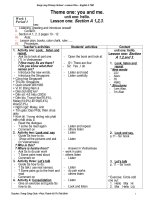Information Seeking in An Electronic Environment: Lesson 1. How has ICT Affected the Information-Seeking Behavior of Users?
Bạn đang xem bản rút gọn của tài liệu. Xem và tải ngay bản đầy đủ của tài liệu tại đây (621.51 KB, 29 trang )
<span class='text_page_counter'>(1)</span><div class='page_container' data-page=1>
<b>ICTLIP Module 3. </b>
<b>Information Seeking </b>
<b>in An Electronic </b>
<b>Environment</b>
Lesson 1.
How has ICT Affected the
</div>
<span class='text_page_counter'>(2)</span><div class='page_container' data-page=2>
<b>Rationale</b>
The format and the mode of access
to information resources have
changed because of the electronic
environment in libraries and the
industry brought about by ICT
Libraries, librarians and users have
</div>
<span class='text_page_counter'>(3)</span><div class='page_container' data-page=3>
<b>Scope of the Lesson</b>
Impact of ICT on the information
industry and services
Format of information resources
Representation of information
seeking tools
Impact of ICT on the user
Information needs
Information seeking behavior
Methods to support user
information needs
Impact of ICT on the librarian and
</div>
<span class='text_page_counter'>(4)</span><div class='page_container' data-page=4>
<b>Learning Outcomes</b>
By the end of the lesson, the student
must be able to:
Appreciate the impact of ICT on the
information industry and services
Know the different formats of information
resources
Know new ways of representing
information in an electronic environment
Understand the information-seeking
</div>
<span class='text_page_counter'>(5)</span><div class='page_container' data-page=5>
<b>What is Information?</b>
Information is anything that can
change a person’s state of
knowledge (What one knows) and
physical representations of
abstractions that can cause this
change.
Information used to be obtained only
from friends, experts, printed books,
serials, audio-visual materials, etc.
Information used to be accessible
</div>
<span class='text_page_counter'>(6)</span><div class='page_container' data-page=6>
<b>The digital environment </b>
<b>has led to changes in </b>
<b>the creation, storage, </b>
<b>What is the Impact of ICT </b>
<b>on information resources </b>
<b>and tools for access?</b>
<b><sub>Internet</sub></b>
<b>Digital:</b>
<b>Digital: CD-ROM, DVD, </b>
<b>DAT</b>
</div>
<span class='text_page_counter'>(7)</span><div class='page_container' data-page=7>
<b>Information Resources </b>
Printed and electronic books
(e-books)
Printed and electronic journals
(e-journals)
Printed and electronic reference tools
(e-dictionaries, e-abstracts and
</div>
<span class='text_page_counter'>(8)</span><div class='page_container' data-page=8>
<b>What is Information </b>
<b>Seeking?</b>
Information seeking is the the process
engaged in by humans to change their
state of knowledge. It is a high level
cognitive process that is part of
learning or problem solving. To seek
information implies the need to change
the state of one’s knowledge.
Information retrieval is concerned with
getting information from databases.
Searching is the behavioral
</div>
<span class='text_page_counter'>(9)</span><div class='page_container' data-page=9>
<b>Ways to Represent </b>
<b>Documents to Support </b>
<b>Information Seeking</b>
Indexing using a standard indexing language (e.g.
Library of Congress Subject Headings List) or a
knowledge-based indexing language (MESH)
Indexing using terms in the document and generating
an inverted file. Boolean algorithms may be used for
searching
Full text indexing or indexing all the words in the
document and (String search)
Treating documents as vectors—Accounts for the
number of times a term is used in the document.
Retrieved document can be ranked.
Latent semantic indexing-Compares an input vector
</div>
<span class='text_page_counter'>(10)</span><div class='page_container' data-page=10>
<b>Developments in </b>
<b>Electronic </b>
<b>Environments</b>
Hardware, data structuring and algorithms
Interfaces—Human computer interaction,
GUIs and WIMPS
Hypermedia research
Research in document representation and
</div>
<span class='text_page_counter'>(11)</span><div class='page_container' data-page=11>
<b>Information Searching </b>
<b>Tools </b>
Printed tools (Card catalog, printed
bibliographies, printed abstracts and
indexes, etc.)
e-tools for library collections(OPAC, Web
OPAC, Online databases—abstracts and
indexes)
Search engines for the Web collection
(Google, Alta Vista Advanced Search,
AllTheWeb), Meta-Search Engines--most
of which are not recommended, others)
Subject Directories
</div>
<span class='text_page_counter'>(12)</span><div class='page_container' data-page=12>
<b>Interactive Information </b>
<b>Seeking</b>
Ranking and relevance feedback support
highly interactive information seeking
<b>Information seeker</b>
<b>Interface</b>
</div>
<span class='text_page_counter'>(13)</span><div class='page_container' data-page=13>
<b>Impact of ICT on the User </b>
Preference in using ICT for fast
efficient comprehensive search for
information.
Efficient global
communication
results in frequent
personal interaction
among researchers.
</div>
<span class='text_page_counter'>(14)</span><div class='page_container' data-page=14>
<b>What is Information </b>
<b>Seeking Behavior?</b>
Reasons for searching and strategies
used to find and use information.
<b>Reference materials</b>
• <b>OPAC/WebPAC</b>
• <b><sub>Abstracts and </sub></b>
<b>indexes</b>
• <b><sub>Dictionaries and </sub></b>
<b>encyclopedias</b>
<b>Full text and </b>
<b>multimedia </b>
<b>materials</b>
<b></b>
</div>
<span class='text_page_counter'>(15)</span><div class='page_container' data-page=15>
<b>Behavioral Model of </b>
<b>Information Seeking or </b>
<b>Literature Searching</b>
Motivations—Reasons for
information seeking
Moves—Strategies used to find
information.
Motivations + Moves
Information seeking
behavior
</div>
<span class='text_page_counter'>(16)</span><div class='page_container' data-page=16>
UNESCO ICTLIP Module 3. Lesson 1 16
<b>Strategies in </b>
<b>Information Seeking</b>
Sources:
Recall
Asking friends, colleagues or experts
Consulting personal collections of books, periodicals
and files
Conducting empirical investigations
Consulting libraries, research firms, electronic
networks
Making use of information services
Methods
Analytical strategies
Browsing strategies
</div>
<span class='text_page_counter'>(17)</span><div class='page_container' data-page=17>
<b>Selected Researches on </b>
<b>Information Seeking</b>
Aguilar (1967), Weick and Daft (1983), Daft
and Weick (1984)
Eisenberg and Berkowitz (1996)
Ellis (1989), Ellis, et. al. (1993), Ellis and
Haugan (1997)
</div>
<span class='text_page_counter'>(18)</span><div class='page_container' data-page=18>
<b>Aguilar (1967), Weick </b>
<b>and Daft (1983), Daft </b>
<b>and Weick (1984)</b>
Modes of organizational scanning
Undirected viewing—Broad scanning
Conditioned viewing—Assessment of
information gathered
Informal search—Search for more
information to deepen knowledge
</div>
<span class='text_page_counter'>(19)</span><div class='page_container' data-page=19>
<b>Eisenberg and Berkowitz (1996)</b>
The Big6
Task definition: Define the problem,
identify the information needed
Information seeking strategies: Brainstorm
all possible sources, select the best
sources
Location and access: Locate sources, Find
information within sources
Use of information: Engage, extract
relevant information
Synthesis: Organize information, present
the result
Evaluation: Judge the result and the
</div>
<span class='text_page_counter'>(20)</span><div class='page_container' data-page=20>
<b>Ellis (1989), Ellis, et. al. </b>
<b>(1993), Ellis and Haugan </b>
<b>(1997)</b>
Model of information seeking behavior
Starting—Identifying sources of interest
Chaining—Pointers from an initial
source are followed
Browsing—Semi-directed search in
areas of potential search
Differentiating—Filtering and selecting
Monitoring—Keeping abreast of
</div>
<span class='text_page_counter'>(21)</span><div class='page_container' data-page=21>
<b>Marchionini (1995)</b>
Browsing modes:
Directed browsing—Focused on a specific
target and systematic
Semidirected browsing—less focused and
systematic but still purposeful
Undirected browsing—No real target and not
systematic
Model of information seeking
Recognize and accept an information problem
Define and understand the problem
Choose a search system
Formulate a query
Execute search
Examine results
</div>
<span class='text_page_counter'>(22)</span><div class='page_container' data-page=22>
Steps in Information Seeking
<b>Recognize </b>
<b>the </b>
<b>problem</b>
<b>Choose an </b>
<b>information </b> <b>Execute </b>
<b>Assess Information. </b>
<b>Modify search, </b>
<b>monitor </b>
<b>Developments or </b>
<b>Stop and synthesize</b>
</div>
<span class='text_page_counter'>(23)</span><div class='page_container' data-page=23>
<b>Impact of ICT on the </b>
<b>Library and the </b>
<b>Librarian</b>
The digital information
environment changed the way
information is created, collected,
consolidated, and communicated.
Library services became
automated and information
services became electronic.
Librarians had to learn new
knowledge and skills in order to
meet user needs for new
</div>
<span class='text_page_counter'>(24)</span><div class='page_container' data-page=24>
<b>Library Services in a </b>
<b>Digital Environment</b>
Automated library system
Services for e-onsite resources:
CD-ROM, journals on subscription,
e-books
Internet services
Information services: SDI, Repackaging
of information
Resource sharing activities:
</div>
<span class='text_page_counter'>(25)</span><div class='page_container' data-page=25>
<b>An Automated Library</b>
An automated library system that
uses a single database for its various
operations and services is called an
integrated library system (ILS)
<b>Catalogin</b>
<b>g </b>
<b>workstati</b>
<b>on</b>
<b>OPAC</b>
<b>Circulation </b>
<b>workstatio</b>
<b>n</b>
</div>
<span class='text_page_counter'>(26)</span><div class='page_container' data-page=26>
<b>USER</b>
<b>The Library in the Digital </b>
Internet
Resources
Other
Libraries
and
Information
Centers
• <sub>Printed books</sub>
and e-books
</div>
<span class='text_page_counter'>(27)</span><div class='page_container' data-page=27>
<b>Impact of the Digital </b>
<b>Environment on </b>
<b>Librarians: New Roles</b>
• Create
• Collect
• Consolidate
• Communicate
• Preserve
Information <sub>User</sub>
</div>
<span class='text_page_counter'>(28)</span><div class='page_container' data-page=28>
<b>Impact of the Digital </b>
<b>Environment on Librarians: </b>
<b>New Knowledge</b>
Understanding of the broader context within
which the information professional works.
User information
Subject
knowledge
User
behavior
Librarian
</div>
<span class='text_page_counter'>(29)</span><div class='page_container' data-page=29>
<b>Conclusion: ICT has Greatly </b>
<b>Affected the Information </b>
<b>Environment </b>
Librarians and other users of information
must adapt to the changing technological
environment to:
be able to use electronic resources and
access tools
be able to respond to new user
information needs and
information-seeking behaviors
be able to participate in the national,
</div>
<!--links-->









